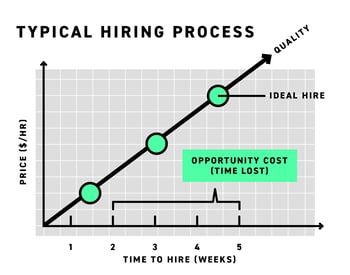The pandemic has caused many businesses to layoff or furlough employees just to survive. Unfortunately, even as the economy begins a slow climb back to normalcy, many employees that couldn’t wait for rehiring have found new work elsewhere, leaving managers with gaps in their team. Let’s assume for a moment that you’ve considered all the rules of hiring: you’re only hiring the best, you’ve waited to see if you can do without a new hire, and you’re hiring to improve your team (not to please your boss). Checked all those boxes? Read on to find out how to make the case to your C-Level and build (or rebuild) the team you need.
1. Assess
Start by finding out exactly why you need a new hire for your team. Maybe the pandemic forced you to furlough someone who picked up work elsewhere. Perhaps someone on your team was promoted but their former position remained unfilled. Or maybe you’re working on an ambitious new project and just need some more help. In any case, the best way to assess the situation is to talk with your existing team to find problem areas.
- Who’s getting overworked and by how much?
E.g. Mobile Developer is putting in 60 hour weeks and showing signs of burnout, like irritability. - What’s not getting done, and what are the consequences?
E.g. Customer service response time delays are leading to negative product reviews. - Are current team members filling in for work they weren’t originally hired for?
E.g. Web Designer tasked with designing urgent social media content at the expense of delaying critical site updates.
2. Be clear about what you’re looking for
With an objective assessment of your current situation, you can essentially write a job description for your ideal hire. The description should include:
- Role and skills
Be as specific as possible. You’re not looking for “a designer,” you need “a mobile UI designer.” - Experience level
Junior, mid-level, or senior? How many years of relevant experience? This can differ depending on the field. - Salary
Based on the experience level and role, what’s a competitive salary you should be prepared to offer?
3. Make the case
Set the stage for making your case carefully. If your company’s revenue is dropping and looking to cut costs, it’s going to be tough to convince your boss to make an expensive new hire. Assuming that’s not the case, try to make the case at the beginning or end of the fiscal year, when budgets are being allocated.
To convince your employer to bring in talent, it’s not enough to tell them why it’ll make your job easier—you have to put yourself in their shoes. Put the hire(s) you’re looking to make in the context of the greater company roadmap. How will their work increase revenue, speed up project development, or otherwise help the company achieve its goals?
Also, make it clear how delays in hiring cause project delays. The traditional vetting, hiring, and onboarding process can take 1-2 months. If you wait until you really need someone to help get a project over the finish line, it’s often already too late. Better yet, hiring help on a project early speeds up the overall process. What’s the opportunity cost of letting a project drag on longer than it needs to?


For the actual meeting, make it a one-on-one, ideally in person, or over a video call. Claims made via email are easier to ignore and harder to empathize with. Start the conversation with the assumption that you’re all working together to do what’s best for the company, even if you don’t necessarily agree on methods. Also realize that while you’re not necessarily going to walk away with an immediate and resounding “go ahead!” but with a little patience, you might get what you’re looking for in the near future.
4. Offer alternatives
Whether your carefully crafted case yields a hard “no” or a non-committal “let’s assess later,” consider compromises that get you part of the way towards your goal. For example, if you really want a full-time hire but don’t have the budget for it, there are a few alternatives that could still get you some of the help you’re looking for.
- Make it temporary
Hire a project-based contractor to help out on a difficult project. It’s easier to sell “part-time contractor” than “permanent full-time hire.” - Promote from within
For example, if another department has a developer with a light workload and an interest in learning a new programming language, you could offer to train them in exchange for assisting your team. - Consider internships
Interns can be fantastic for dealing with basic tasks, are generally compensated less than a salaried hire, and often make great hires after the internship stint is over. Just be aware that their inexperience requires more supervision and training.
Whatever compromise you make, you’ll probably find it’s easier to convince the higher-ups to keep someone who’s already working with you and has demonstrated value than to make a new hire from scratch. In other words, you might end up getting exactly what you wanted in the end, albeit just not in the way you thought you would.
Either way, good luck making the case! When you get the go-ahead to make a new hire or bring on a contractor, Artisan has the talent you’re looking for.




